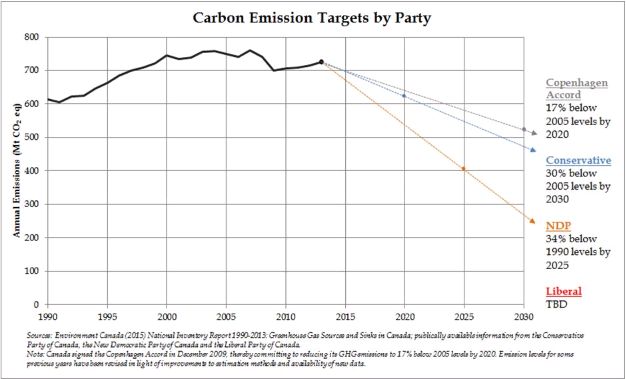As election mania heats up in Canada, it is becoming increasingly important to analyze and contrast how the three front-running parties, the Conservatives, the Liberals and the NDP, intend to deal with key electoral issues. Two of such issues involve the economy and the environment, of which energy, and specifically carbon emissions, make up a fundamental piece. In response, each party has released its own platform aimed at tackling carbon emissions in an effort to fight climate change. When questioned, each party gives the impression that its own policy represents the best balance between economic stability and curbing emissions and to vote for any other platform would ensure economic collapse on one end, or environmental destruction on the other. However, a closer look at each policy actually reveals more similarities than differences. Obviously, more useful and relevant than campaign policies and promises will be examining what the successful party (assuming a majority government) or parties (in the event of a minority coalition) implement after the election is complete. We will return to this topic after the election to examine where policies and promises diverge in practice.

The Conservatives have set a carbon emissions target of 30% below 2005 values by 2030, the NDP have committed to an emissions reduction target of 34% below 1990 levels by 2025 and the Liberals, while promising to put a price on carbon, have declined to provide a firm reduction target. On its face, each platform appears to be unique, but, as always, the devil is in the details. The Conservative stance, which has received significant criticism from the Liberals, the NDP and environmentalists alike, has been and will continue to be, total reliance on provincially implemented carbon reduction programs. This closely mirrors the approach taken by the Conservatives when they overhauled the Canadian Environmental Assessment Act in 2012. In contrast, the NDP have promised to implement a national cap-and-trade program, but they too will allow for a provincial opt out, provided that the provincial guidelines meet or exceed the federal requirements. The Liberals, falling somewhere in the middle, intend to implement a federal emissions target, but will leave the implementation on how to achieve this target up to the individual provinces. In other words, each party's carbon emissions platform either allows for, or encourages, most of the heavy lifting to be done by the provinces. In fact, the federally weighted NDP plan recently came under fire from the NDP's very own Rachel Notley, the premier of Alberta, who stated that a national regime may not fit well with the diverse nature of the Canadian economy.
With each of the three parties garnering approximately one third of the popular vote (based on present day polling), it remains to be seen what will occur on Election Day. However, no matter the result of the federal election, the future of Canada's emissions policy will be left, at least partly, in the hands of the provinces. Wasting no time, British Columbia and Quebec have already implemented plans of their own, while Ontario and Alberta, are following in their footsteps. This onset of emissions regulation means that businesses and governments must start accounting for carbon output and the associated flow through costs throughout their strategic planning processes. Many businesses have done just that already. Former Bank of Canada Governor Mark Carney recently warned that a high price on carbon could render many fossil fuel reserves unburnable. These "stranded assets" could have a debilitating effect on many resource firms, which can have a ripple effect throughout the Canadian economy at large. While it is our impression that climate change policies and promises have not yet taken centre stage during this election campaign, the December UN talks in Paris, and bilateral initiatives recently announced between China and U.S.A., mean that climate change and carbon policy will inevitably be on the top of the the international agenda and any future federal government of Canada, together with the provinces, will need to tackle this reality.
The content of this article is intended to provide a general guide to the subject matter. Specialist advice should be sought about your specific circumstances.
